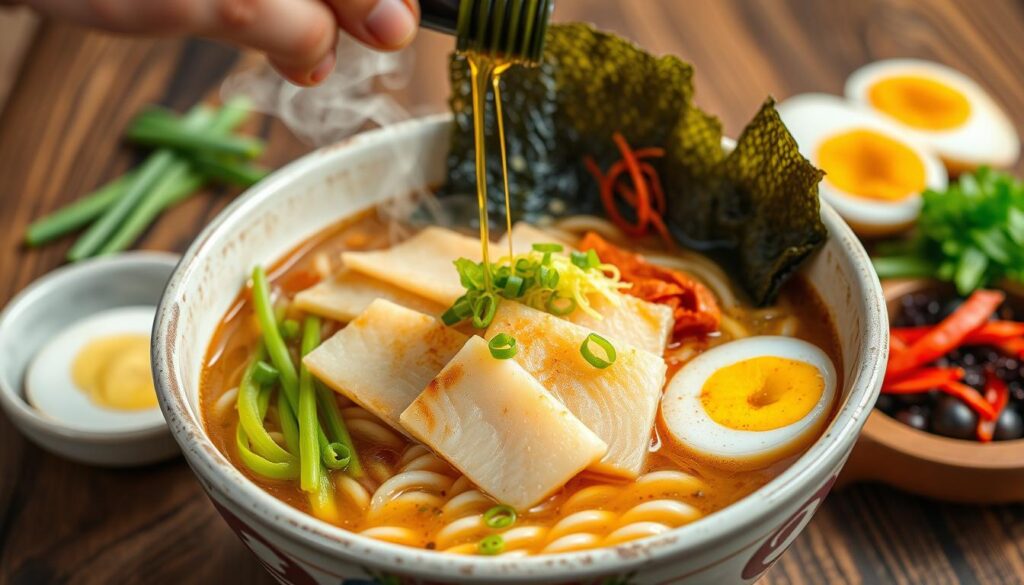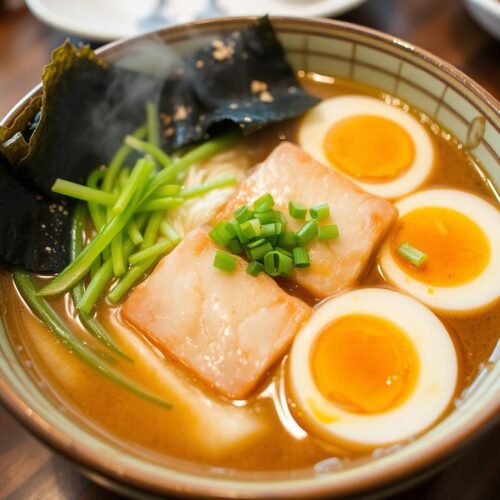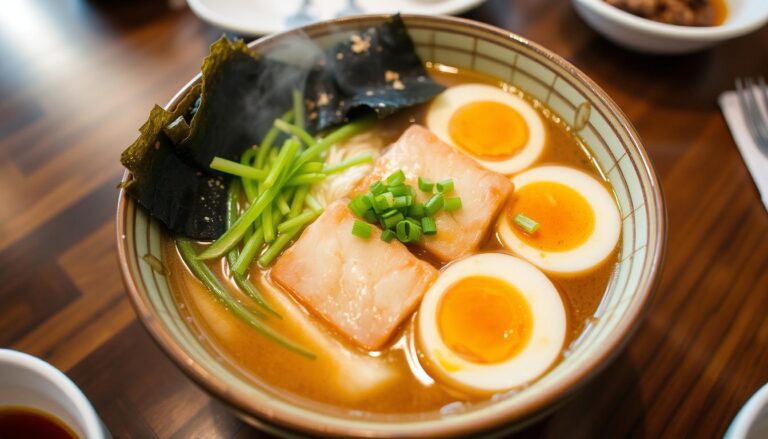Imagine a dish that brings the taste of Japanese cuisine to life. You’re thinking of fish cake ramen. It’s a comfort food that warms the heart. It combines flavor, tradition, and art in every bite. This meal reflects Tokyo’s lively street food scene. It offers a seafood delight that brightens everyday meals.
The white fish narutomaki adds a beautiful touch. It also honors the Naruto Strait’s famous whirlpools. Dive into this culinary journey where taste meets tradition. It’s all in a comforting bowl of flavor. It’s made to satisfy both your heart and stomach.
Key Takeaways
- Explore the depth of fish cake ramen. It’s a journey through Japanese cuisine‘s soulful history.
- See how narutomaki, the fish cake, draws from the Naruto Strait. It adds a unique touch to the ramen.
- Discover how easy it is to make this comfort food. It’s great for beginners and expert chefs.
- Enjoy a seafood delight that brings Tokyo’s street food to your home. It’s a taste adventure.
- Get inspired for your next cozy meal. It fills you up and brings warmth like Japanese hospitality.
The Allure of Fish Cake Ramen: Unraveling its Comforting Appeal
Fish cake ramen stands out in comfort food for its texture and flavor harmony. The tempting ramen toppings turn a simple dish into a work of art. Especially, the savory fish cakes, or narutomaki, with their soft and bouncy feel, match the broth beautifully.
Homemade narutomaki are not just about looks; they’re rich in tradition. They add a deep umami flavor to the ramen. Making narutomaki takes skill, showing the craft behind this favorite.
To fully enjoy fish cake ramen, consider the broth and toppings together. At Mami Recipes, they understand this balance well. Their recipes show how well meat and potatoes blend with fish cake ramen.
The dish changes beautifully with different toppings. Be it fresh scallions, a soft-boiled egg, or sesame seeds, each adds to the dish’s charm. These toppings wrap the dish in what feels like a warm hug.
Fish cake ramen, with ingredients like homemade narutomaki and savory fish cakes, creates a unique meal. It celebrates the spirit of Japanese cooking, making every bite a moment of joy.
Tracing the Roots of Fish Cake Ramen: A Journey Through Japanese Cuisine
The streets of Tokyo pulse with life, just like the evolving world of ramen. In the heart of Japan’s capital, old flavors and new twists come together. This fusion creates culinary delights, including unique ramen with narutomaki.
Understanding the Tokyo Street Food Influence on Ramen Evolution
Street food in Tokyo plays a big role in ramen’s diversity. From Shibuya’s bustling avenues to Asakusa’s quaint stalls, Tokyo shows the changing world of ramen. Chefs mix broths, noodles, and toppings like narutomaki. They turn simple ramen into gourmet meals.
How Narutomaki Became a Staple in Fish Cake Ramen
Narutomaki, known for its pink swirl, started in the Naruto Strait. It’s famous for its swirling tides. This fish cake adds beauty and umami flavor to ramen.
Narutomaki in ramen is more than just looks. It mixes art with flavor. It has become essential in many ramen dishes.
| Ramen Ingredient | Culinary Significance | Origin |
|---|---|---|
| Narutomaki | Adds a unique swirl pattern and a mild fish flavor | Naruto Strait inspired |
| Broth (Tonkotsu, Shoyu, Miso) | Foundation of ramen, influencing its overall taste profile | Varies by region in Japan |
| Noodles (Thin, thick, wavy) | Determines the texture and soup retention | Adaptations based on preferred broth type |
As Tokyo’s street food scene thrives, ramen’s evolution goes on. It brings traditional and modern flavors together in bowls that delight people all over the world.
Creating Narutomaki: The Art Behind Fish Cake Ramen’s Signature Topping
Making narutomaki mixes old fish paste methods with a bit of kitchen creativity. The journey starts by turning quality white fish into a smooth paste. Ingredients like egg whites and cornstarch are added, improving the mix’s bind and texture. For its famous swirl, red food coloring is used. Some might use beet juice for the pink spiral.
This food art is a treat for both taste and sight, making it key for any ramen. The swirl in narutomaki isn’t just pretty; it represents the Naruto Strait’s whirlpools, combining cooking and culture. Making the perfect spiral needs skill and patience, showing the essence of kitchen creativity.
Narutomaki’s chewy feel contrasts well with soft ramen noodles, adding to the meal. This part talks about the main steps in making narutomaki. It’s celebrated as peak kitchen creativity and shows off fish paste techniques.
Brewing the Ultimate Seafood Broth: The Foundation of Flavorful Ramen
Creating seafood broth is key for genuine fish cake ramen. It captures the essential tastes of Japanese food. These tastes blend together, releasing umami. This umami is what makes the broth so flavorful and comforting.

The Role of Umami in Enhancing the Broth’s Richness
Umami is known as the fifth taste. It’s vital in Japanese cooking, especially for seafood broth. Crucial ingredients like kelp and bonito flakes are used. They add deep flavors and richness to the broth, making it irresistible.
Ingredients That Elevate the Fish Cake Ramen Experience
For an excellent seafood broth, choosing top-notch ingredients is vital. Using fresh fish, shiitake mushrooms, and a bit of miso makes the broth special. These add depth to the broth and match the narutomaki and other toppings well.
Selection Guidelines for Ramen Noodles: Achieving the Perfect Slurp
Ramen noodles play a vital role in creating an authentic fish cake ramen dish. They impact the dish’s texture and feel, making the eating experience truly Japanese. Good ramen noodles blend with the flavors of seafood broth and narutomaki. They stay firm, allowing for that satisfying slurp.
Choosing between fresh and dried noodles affects the dish’s texture. Fresh noodles are softer and cook quickly, helping to avoid mushiness. Dried noodles last longer and have a firmer texture. They withstand the broth’s richness well.
Trying various recipes helps find the perfect balance of flavors and textures. Check out different recipes to improve your ramen game.
| Noodle Type | Texture | Cooking Time |
|---|---|---|
| Fresh | Soft and elastic | 1-2 minutes |
| Dried | Firm to the bite | 4-5 minutes |
Choosing the right noodles transforms ramen into a dish that speaks to authentic Japanese cuisine. It’s about more than taste. It’s about how the noodles absorb flavors and remain resilient, capturing the heart of a great ramen dish.
Tailoring Your Bowl: Alternate Ramen Toppings and Add-Ons
Make your ramen special by choosing from a range of add-ons and toppings. Discover new tastes and textures. Make your ramen perfectly fit what you like.
From Savory Fish Cakes to Crisp Nori Seaweed Garnish
It’s not just about more ingredients. It’s about picking the right ones. A nori seaweed garnish adds crunch and a taste of the sea. This makes your dish special.
- Fish cakes: Adds a savory chewiness
- Nori seaweed: Provides a crispy, salty upgrade
- Soft boiled egg: Creamy, rich, and velvety
Combining Flavors: The Synergy of Aromatic Oils and Bright Veggies
Adding aromatic oils and fresh veggies changes everything. Your ramen becomes colorful and fragrant. These additions also make your meal healthier and more satisfying.
| Veggie | Benefit | Suggested Aromatic Oil |
|---|---|---|
| Bok Choy | Crunchy texture, rich in Vitamins A and C | Sesame oil |
| Shredded Carrots | Sweetness and vibrant color | Garlic oil |
| Green Onions | Bright, peppery snap | Chili oil |

Think about what you like when customizing your ramen. Harmonizing textures and flavors is key. Choices like pork belly, scallions, or aromatic oils matter. With creativity and love, every bite can be an adventure.
Healthier Ramen Variations: Nutritional Benefits of Fish Cake Ramen
Healthy ramen includes fish cake ramen, known for its nutritional benefits. Ingredients aim to boost both taste and health. It features narutomaki. This adds a protein-rich and low-calorie element to meals. Adding diverse veggies and low-sodium broths makes it both healthy and tasty.
To explore more on healthy cooking, see this guide on making Kodiak pancakes. They are nutritious and ideal for breakfast.
Here’s what makes fish cake ramen good for you:
| Ingredient | Nutritional Highlight |
|---|---|
| Narutomaki (Fish Cake) | Low in calories, high in protein |
| Vegetables (e.g., Spinach, Mushrooms) | Rich in vitamins, minerals, and fiber |
| Broth | Option for low sodium variations |
| Noodles | Choice of whole grain for added fiber |
Healthy ramen offers more than just great taste. It also ensures a meal full of nutritional benefits. It’s perfect for those who love food and health equally.
Complementing the Bowl: What to Serve with Fish Cake Ramen
A complete ramen meal blends many flavors and textures. Each part is vital for a perfect dining experience. Adding side dishes like steamed bok choy or green beans can make the meal even better. These sides bring a fresh taste and look to the hearty ramen.
They’re not just tasty; they’re also good for you. These veggies make the meal balanced and beautiful.
Side Dishes That Bring Color and Texture Contrast
Great dishes come from the little details of flavor and look. A tangy pickled salad can contrast the ramen’s rich flavors nicely. Adding crispy tempura veggies can bring an exciting texture to your meal. These sides make the ramen more enjoyable, ensuring every bite is as good as the last.
Pairing Beverages for a Complete Dining Experience
Beverages are key to the ramen experience too. Green tea can refresh your taste and pair well with the ramen’s flavors. After eating, try a piece of Japanese cheesecake for a sweet finish. If you’re looking to try new things, check out lobster meat recipes. They can add a luxurious touch to your meal, perfectly matching the ramen.
FAQ
What makes fish cake ramen a comforting kind of comfort food?
Fish cake ramen combines narutomaki, tender noodles, and a rich seafood broth. This blend creates a comforting bowl. Its flavors and textures offer a satisfying experience of Japanese cuisine.
Can homemade narutomaki be made easily at home?
Yes, making narutomaki at home is doable for anyone. It starts with making a fish paste from white fish. Then, it’s rolled with a swirl pattern and steamed. It’s a fun process that requires patience.
How has Tokyo street food influenced the evolution of ramen?
Tokyo street food has brought new flavors to ramen, including fish cake ramen. Vendors added diverse toppings over time. These have become part of mainstream ramen culture.
Why is narutomaki a staple in fish cake ramen?
Narutomaki features a unique pink swirl. This design is inspired by natural whirlpools. Its mild flavor and chewy texture enhance the ramen’s appeal.
What are some tips for creating the perfect seafood broth for ramen?
For a great seafood broth, select ingredients like mirin and sugar carefully. Aim for a broth that adds depth. This base should complement the ramen’s other elements well.
What should I look for when selecting ramen noodles for fish cake ramen?
Choose noodles that balance firmness with slurpability. Whether fresh or dried, noodles should keep their texture in the broth. They shouldn’t get too soft.
What are some alternative toppings I can use in fish cake ramen?
Besides narutomaki, consider toppings like savory fish cakes, crispy nori, and bamboo shoots. Adding a soft-boiled egg, sesame seeds, or vibrant vegetables can personalize your bowl.
Is fish cake ramen a healthy meal option?
Fish cake ramen is a healthy option. Narutomaki is low in calories but high in protein. Using vegetables and less sodium in your broth makes it even healthier.
What kinds of side dishes and beverages pair well with fish cake ramen?
Steamed vegetables like bok choy make great sides. Green tea complements the umami of the ramen well. For dessert, a light Japanese cheesecake provides the perfect sweet finish.

Fish Cake Ramen Recipe
Equipment
- Large pot for broth
- Medium pot for boiling ramen
- Knife and cutting board
- Ladle for serving
Ingredients
- 4 cups chicken or vegetable broth
- 2 packs ramen noodles instant or fresh
- 1/2 cup soy sauce
- 1 tbsp miso paste optional, for extra flavor
- 1 tbsp sesame oil
- 2 cloves garlic minced
- 1- inch piece of ginger minced
- 1 cup fish cakes Narutomaki, thinly sliced
- 1/2 cup green onions chopped
- 1 soft-boiled egg per bowl, optional
- 1/2 cup spinach or bok choy optional
- 1 tbsp sesame seeds for garnish
- 1 sheet nori seaweed, cut into strips (optional)
Instructions
Prepare the Broth:
- In a large pot, heat the sesame oil over medium heat. Add the minced garlic and ginger and sauté for about 1-2 minutes until fragrant.
- Add the chicken or vegetable broth, soy sauce, and miso paste (if using). Stir well to combine and bring the mixture to a simmer. Let it cook for about 5-7 minutes to develop the flavors.
Cook the Ramen Noodles:
- In a separate pot, cook the ramen noodles according to the package instructions. Drain and set aside.
Add the Fish Cakes:
- While the broth is simmering, add the sliced fish cakes (Narutomaki) to the broth and allow them to heat through for about 2 minutes.
Assemble the Ramen Bowls:
- Divide the cooked ramen noodles into serving bowls. Ladle the hot broth over the noodles, making sure to add the fish cakes.
Top the Ramen:
- Top each bowl with green onions, soft-boiled egg, spinach or bok choy (if using), sesame seeds, and strips of nori.
Serve:
- Serve the ramen hot and enjoy immediately.
Notes
If you can’t find Narutomaki, you can use other types of fish cakes or substitute with tofu for a vegetarian option.
Adjust the soy sauce and miso paste according to your taste preference.



